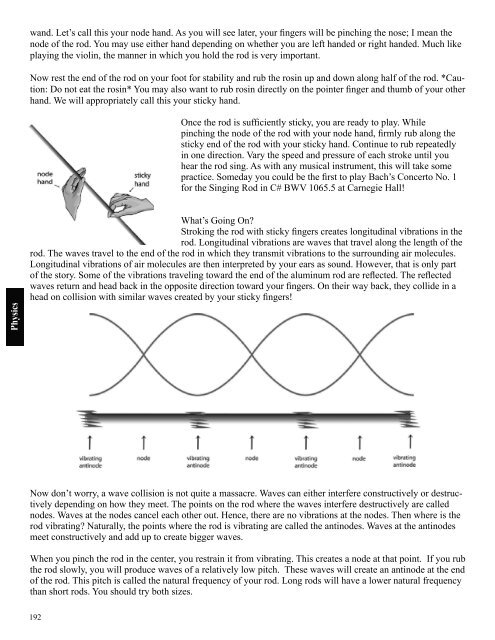ScienceMakers Toolkit Manual - The History Makers
ScienceMakers Toolkit Manual - The History Makers
ScienceMakers Toolkit Manual - The History Makers
You also want an ePaper? Increase the reach of your titles
YUMPU automatically turns print PDFs into web optimized ePapers that Google loves.
Physics<br />
wand. Let’s call this your node hand. As you will see later, your fi ngers will be pinching the nose; I mean the<br />
node of the rod. You may use either hand depending on whether you are left handed or right handed. Much like<br />
playing the violin, the manner in which you hold the rod is very important.<br />
Now rest the end of the rod on your foot for stability and rub the rosin up and down along half of the rod. *Caution:<br />
Do not eat the rosin* You may also want to rub rosin directly on the pointer fi nger and thumb of your other<br />
hand. We will appropriately call this your sticky hand.<br />
192<br />
Once the rod is suffi ciently sticky, you are ready to play. While<br />
pinching the node of the rod with your node hand, fi rmly rub along the<br />
sticky end of the rod with your sticky hand. Continue to rub repeatedly<br />
in one direction. Vary the speed and pressure of each stroke until you<br />
hear the rod sing. As with any musical instrument, this will take some<br />
practice. Someday you could be the fi rst to play Bach’s Concerto No. 1<br />
for the Singing Rod in C# BWV 1065.5 at Carnegie Hall!<br />
What’s Going On?<br />
Stroking the rod with sticky fi ngers creates longitudinal vibrations in the<br />
rod. Longitudinal vibrations are waves that travel along the length of the<br />
rod. <strong>The</strong> waves travel to the end of the rod in which they transmit vibrations to the surrounding air molecules.<br />
Longitudinal vibrations of air molecules are then interpreted by your ears as sound. However, that is only part<br />
of the story. Some of the vibrations traveling toward the end of the aluminum rod are refl ected. <strong>The</strong> refl ected<br />
waves return and head back in the opposite direction toward your fi ngers. On their way back, they collide in a<br />
head on collision with similar waves created by your sticky fi ngers!<br />
Now don’t worry, a wave collision is not quite a massacre. Waves can either interfere constructively or destructively<br />
depending on how they meet. <strong>The</strong> points on the rod where the waves interfere destructively are called<br />
nodes. Waves at the nodes cancel each other out. Hence, there are no vibrations at the nodes. <strong>The</strong>n where is the<br />
rod vibrating? Naturally, the points where the rod is vibrating are called the antinodes. Waves at the antinodes<br />
meet constructively and add up to create bigger waves.<br />
When you pinch the rod in the center, you restrain it from vibrating. This creates a node at that point. If you rub<br />
the rod slowly, you will produce waves of a relatively low pitch. <strong>The</strong>se waves will create an antinode at the end<br />
of the rod. This pitch is called the natural frequency of your rod. Long rods will have a lower natural frequency<br />
than short rods. You should try both sizes.










